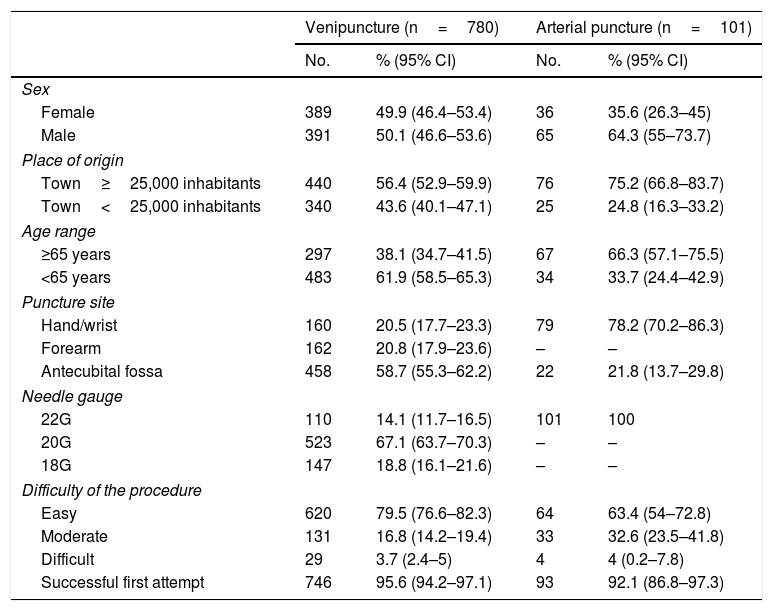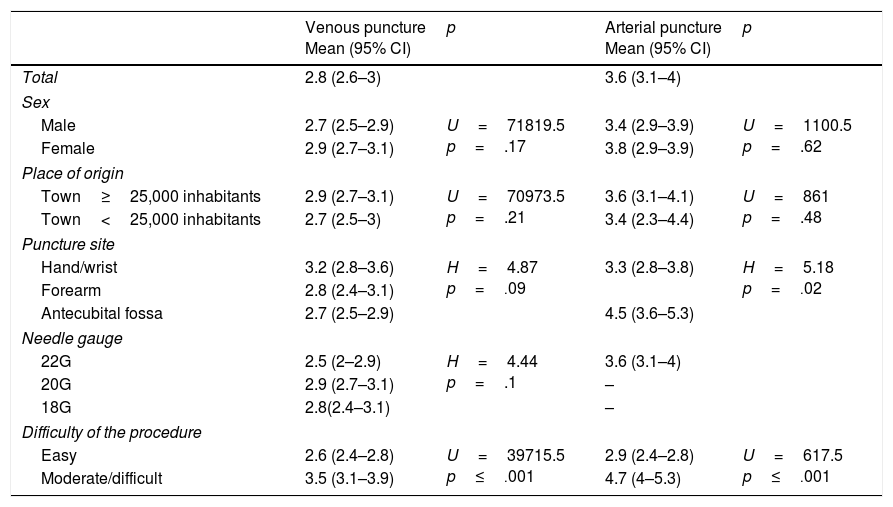To analyse vein catheterisation and blood gas test-related pain among adult patients in the emergency department and to explore pain score-related factors.
MethodAn observational and multicentre research study was performed. Patients undergoing vein catheterisation or arterial puncture for gas test were included consecutively. After each procedure, patients scored the pain experienced using the NRS-11.
Results780 vein catheterisations and 101 blood gas tests were analysed. Venipuncture was scored with an average score of 2.8 (95% CI: 2.6–3), and arterial puncture with 3.6 (95%CI 3.1–4). Iatrogenic pain scores were associated with moderate–high difficulty procedures (p<.001); with the choice of the humeral rather than the radial artery (p=.02) in the gas test and correlated to baseline pain in venipunctures (p<.001). Pain scores related to other variables such as sex, place of origin or needle gauge did not present statistically significant differences.
ConclusionsVein catheterisation and blood gas test-related pain can be considered mild to moderately and moderately painful procedures, respectively. The pain score is associated with certain variables such as the difficulty of the procedure, the anatomic area of the puncture or baseline pain.
A better understanding of painful effects related to emergency nursing procedures and the factors associated with pain self-perception could help to determine when and how to act to mitigate this undesired effect.
Analizar el dolor asociado a la inserción de catéteres venosos y extracción de sangre arterial en pacientes adultos que acuden a urgencias, y explorar posibles factores relacionados con su intensidad.
MétodoEstudio observacional multicéntrico. Se incluyeron consecutivamente pacientes que requerían un catéter venoso periférico y/o una extracción de sangre arterial para gasometría. Se preguntó por el dolor experimentado después de cada técnica, empleando la escala NRS-11.
ResultadosSe evaluaron 780 canalizaciones venosas y 101 gasometrías. Las venopunciones obtuvieron una puntuación media de 2,8 (IC 95%: 2,6-3) y las gasometrías de 3,6 (IC 95%: 3,1-4). El nivel de dolor iatrogénico se asoció a la dificultad técnica media o alta del procedimiento (p<0,001), a la elección de la arteria humeral en lugar de la radial (p=0,02) en las gasometrías y se correlacionó con el dolor basal en las venopunciones (p<0,001). El nivel de dolor en función de otras variables como el sexo, la procedencia o el calibre de la aguja no presentó diferencias estadísticamente significativas.
ConclusionesEl dolor derivado de la cateterización venosa y la punción arterial para gasometría es leve-moderado y moderado, respectivamente, y su intensidad se asocia a variables como la dificultad del procedimiento, el lugar de punción o el dolor basal.
Un mayor conocimiento de los efectos dolorosos derivados de cada procedimiento de enfermería durante la asistencia en urgencias y de los factores que se asocian a la autopercepción del mismo podría ayudar a determinar cuándo y cómo debería intervenirse para mitigar este efecto indeseado.








